Constantijn Huygens: Lord of Zuilichem (1596–1687)
by Adelheid Rech
by Adelheid Rech
After October 1627, Huygens and his family lived in a house at Lange Voorhout (fig. 1). In March 1634, Frederik Hendrik gave Huygens a building lot at the "Plein", close to the government's buildings in the "Binnenhof" and near to the "Mauritshuis" (designed 1638 by Jacob van Campen (1596–1657) and Pieter Post (1608–1669) for Count Johan Maurits van Nassau-Siegen (1604–1679), nephew of Frederik Hendrik and Maurits, called "de Braziliaan").
Huygens threw himself immediately into the plans for a stately home, guided by Post and Jacob van Campen, who had painted of Huygens' double portrait and one of Holland's leading architects in that time. Van Campen was also the architect of the impressive city hall of Amsterdam. Due to Constantijn's frequent absences from home Suzanna had to manage the building and financing of the new house. However, by February 1637 the building had advanced enough to permit the family to move into the new home which they had looked forward to. But the tragic death of Suzanna brought Constantijn's dream to an end. Huygens was hardly able to write some short Latin notes in his diary, reading:
10. May: She returned her spirit to God 30 minutes after the fifth evening hour. Alas, mydelight! Alas, my soul!
16. May: Her body has been committed to earth attended by a huge crowd.
17. May: Moved to the new house, alas! without my dove.Peter Davidson and Adriaan van der Weel, A Selection of the Poems of Sir Constantijn Huygens (1596–1684) (Amsterdam: Amsterdam University Press, 1996), 110–111.
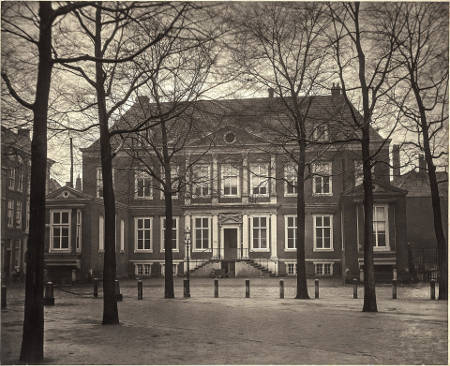 fig. 1 A photograph of Het Plein with the Huygneshuis before it had been demolished in 1876.
fig. 1 A photograph of Het Plein with the Huygneshuis before it had been demolished in 1876. fig. 2 Huygens' coat of arms
fig. 2 Huygens' coat of arms 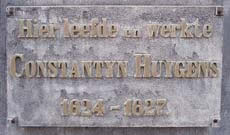 Commemorative plaque on a house at Lange Voorhout
Commemorative plaque on a house at Lange VoorhoutEventually the shattered Huygens composed, inspired by Petrarch, the sonnet Op de dood van Sterre"Op de dood van Sterre" translates to "On the Death of Sterre" in English. The poem is an elegy or a lamentation written in response to the death of Sterre. The poem is a poignant and emotional work that explores themes of love, mortality, and the ephemeral nature of lifeand an example of Huygens' skill as a poet and his ability to capture complex emotions in his verses. It is considered one of his notable works and is often studied and analyzed in the context of Dutch literature and poetry of the 17th century. The poem provides insight into the literary and emotional world of Constantijn Huygens during his time. (On the death of Sterre). He added the poem to his Dagh-werck, which he left unfinished: the day he has described has not ended yet, but his "Sterre" is already dead.
So one day after Suzanna's burial, Huygens, now a widower, moved with his five children into the new house. The children became the center of his private life and just as his own father had done, Huygens took the greatest care in every facet of their education spending as much time with them as he could afford. He wrote many poems for them, played music with them or accompanied them to celebrations and parades. His relationship, unique even in the Netherlands where children had a special standing amongst all European countries, could be seen as an early kind of modern fatherhood.
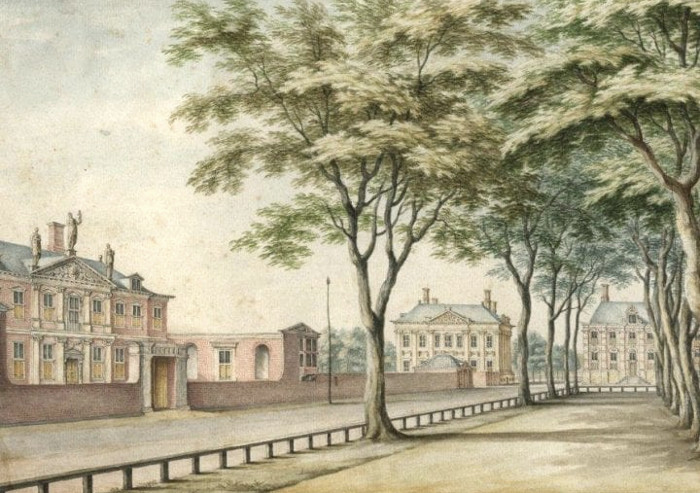 Het Plein in Den Haag
Het Plein in Den Haag Despite the pain for the death of his wife, Huygens made his first steps in his career. In 1630, aside his profession as the secretary of Frederik Hendrik, he was appointed by the Council of the Domains as the "reekenmeester," a financial administrator to the House of Orange. This job provided him with a handsome income of about 1,000 florins a year. To demonstrate his enhanced social status he purchased the manor and title of Zuilichem, in the province of Gelderland.Zuilichem is a small village located in the province of Gelderland in the Netherlands, where Huygens had a substantial manor house. During this time period, manor houses were often used as country residences by affluent individuals and served as centers of agricultural and rural activities. The manor at Zuilichem likely served as a country retreat for Constantijn Huygens and his family. It provided a peaceful and rural setting away from the urban environment of The Hague, where he spent much of his life. His title, "Lord of Zuilichem," may had been benefited him nicely during his visit to Paris c. 1630 where he became personally acquainted with the French philosopher René Descartes (1596–1650), with whom he maintained a lively correspondence, for 122 letters between Descartes and Huygens are still extant.
Descartes used his relationship with Huygens in order to appeal to this influential virtuoso to act as a mediator to print several of his works. Huygens' mediation was crucially important for the publication of Descartes's most famous publication, Discours de la Méthode (1637). Huygens acquired a coat of arms (fig. 2) from his appointment as knight by James VI.
In 1632, Louis XIII knighted Huygens to the order of Saint Michael and was later (1643) allowed a golden lily on a blue ground to be added to his coat of arms. This was perhaps the only conceit which Huygens indulged himself in.
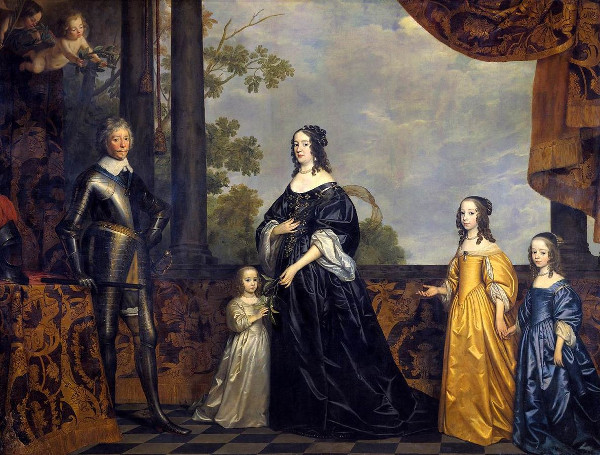 Prince Frederik Hendrik with His Wife Amalia
van Solms and Their Three Youngest Daughters
Prince Frederik Hendrik with His Wife Amalia
van Solms and Their Three Youngest Daughters With the return of the stadtholders' residence to The Hague—William of Orange had temporarily settled his residence to Delft which had a better fortification in those times—the city became more and more the political center of the Republic, a fact which required increased tasks in representation. Although the interests of the stadtholder Maurits had been primarily focused on military matters, it was now up to Frederik Hendrik to develop court life and culture. An important part in this enterprise was the creation of an art gallery. Frederik Hendrik couldn't have had a more accomplished candidate for this task than his secretary Constantijn Huygens.
From his youth Huygens had always nurtured a profound interest in all the art forms maintaining extensive correspondence with a host of local and international musicians, scientists and philosophers. His artistic intuition, coupled with his wide-ranging cultural background, produced a connoisseur of the highest level and the finest possible advisor for introducing the arts into the courtly culture.
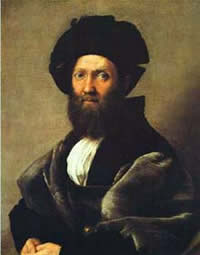 fig. 3 Portrait of Baldassare Castiglione
fig. 3 Portrait of Baldassare Castiglione It is well known from his notes on famous and not-yet-so-famous painters of his time that he was a true connoisseur. In addition, Huygens collected paintings by Scorel, Brueghel, Elsheimer, Saenredam, Brouwer, Palamedes, Vlnckboons, Molenaer and Teniers.
But what treatises on painting did Huygens own in his formidable personal library? Surprisingly, his book catalogue includes only an edition of Leonardo da Vinci's Trattato della pittura and a copy of Franciscus Junius' Painting of the AncientsIn 1637, Junius published De pictura veterum whioch was translated as On the Painting of the Ancients in 1638, and as De Schilder-konst der Oude begrepen in drie boecken in 1641, reprinted 1659. (1638). The catalogue includes far more titles on architecture, from Vitruvius to Sebastiano Serlio. Perhaps many of the books on painting may have been transferred to the libraries of his sons.
It was no doubt Huygens' insatiable curiosity and love of art which lead him to Leiden in 1628 to visit the shared studio of the young Rembrandt (1606–1669) and Jan Lievens (1607–1674). This historic encounter in detail in his autobiography. Both artists made a deep impression to him. Although Huygens found Lievens more open-minded and inventive of the two, he realized that Rembrandt possessed a finer touch and was able to communicate motions more intensely in his work. Huygens' attention towards the two fledging artists contributed to the eventual success of both. He commissioned Lievens to paint his portrait and Rembrandt to paint his brother's (see below for both paintings).
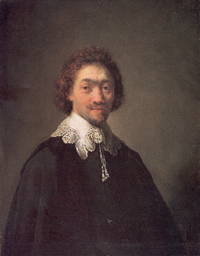 Portrait of Maurits Huygens
Portrait of Maurits Huygens 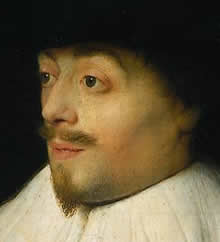 Portrait of Constantijn Huygens (detail)
Portrait of Constantijn Huygens (detail) 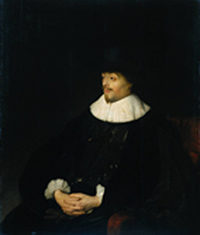 Portrait of Constantijn Huygens
Portrait of Constantijn Huygens Huygens was particularly impressed by Rembrandt's Judas Repentant, Returning the Pieces of Silver and wrote in his autobiography:
"The singular gesture of the despairing Judas—leaving aside the many fascinating figures in this one painting—that one furious Judas, howling, praying for mercy, but devoid of hope, all traces of hope erased from his countenance, his appearance frightening, his hair torn, his garment rent, his limbs twisted, his hands clenched bloodlessly tight, fallen prostrate on his knees on a blind impulse, his whole body contorted in wretched hideousness. Such I place against all the elegance that has been produced throughout the ages. ... I maintain that it did not occur to Protagenes, Appeles or Parrhasius, nor could it occur to them were they return to earth that (I am amazed simply to report this) a youth, a Dutchman, a beardless miller, could bring together so much in one human figure and express what is universal. All honor to thee, my Rembrandt!"Excerpt from the manuscript autobiography of Constantijn Huygens (1629–1631), Koninklijke Bibliotheek, The Hague, published in Oud Holland, 1891, translated by Benjamin Binstock. See Art Humanities Primary Source Reading 29, section 7: Rembrandt.
Huygens saw Rembrandt as the Dutch answer to Rubens; a local artist capable of raising the reputation of Dutch painting to the highest level. He declared the young Rembrandt to be superior even to the ancient Greeks with his ability to integrate accurate observations of emotion into themes of universal applicability. Huygens encouraged Rembrandt to focus on religious and mythological themes and stressed that both he and Lievens ought travel to Italy and study the great Italian masters.
Oh, if only they could be acquainted with Raphael and Michelangelo, how eagerly their eyes would devour the monuments of these prodigious souls. How quickly they would surpass them all, giving Italians due cause to come to their own Holland. If only these men knew that they were born to raise art to consummate heights!
translated by Benjamin BinstockExcerpt from the manuscript autobiography of Constantijn Huygens (1629–1631), Koninklijke Bibliotheek, The Hague, published in Oud Holland, 1891, translated by Benjamin Binstock. See Art Humanities Primary Source Reading 29, section 7: Rembrandt.
My Lord,
Because of the great pleasure and devotion that I have put into the execution of the two pieces which his Highness has had me make, being the one where the dead body of Christ is laid in the grave and the other one where Christ rises up from the dead to the great shock of the guards. These same two pieces are now complete as well due to studious diligence so that I am now also inclined to deliver these in order to please his Highness since in these two the greatest and the most natural movement is observed which is also the reason that I have had them so long in my hands.
I therefore would request if my lord could please tell his Highness of this and if my lord could please have the two pieces first delivered to your house as happened before. I will wait first for a short note to this effect.
And since my lord will be bothered with this business for the second time in recognition a piece 10 feet long and 8 feet high will be included as well which will do honor to my lord in his house. I wish you all happiness and the blessing of salvation, Amen.
Your Lordship,
my lord's r. and devoted servant
Rembrandt
the 12 January
1639
My lord I live on the inner Amstel, the house is named the "sugar bakery"
In any case, Huygens was not blindly submissive towards Italian culture. In his manuscript he cited examples of the moderns and specifically the Dutch surpassing the ancients, such as Dutch landscape painting, and he praises the simplicity and practicality of the Dutch tongue. Far from empty rhetoric, then, Huygens' claim that Rembrandt had surpassed the art of antiquity and Italy is a self-conscious celebration of Dutch culture and identity.
But the two young men saw no necessity in such a travel, and their ostensible response that the best Italian paintings in their time were found north of the Alps is borne out by examples such as Raphael's portrait of Baldesarre Castiglione (fig. 3), which Rembrandt viewed and copied at an auction in Amsterdam and then adapted in several works. Huygens was disappointed by their "apathy."
I can scarcely tear myself away from discussing these outstanding youths, yet I can not help but censure them for the one fault which I have already noted in Lievens. They are securely contented with themselves and neither has hitherto found it important to spend a few months traveling through Italy. In such great talents there is naturally a touch of madness, which can destroy young spirits. If only someone could drive this folly from their young heads, he would truly contribute the sole element needed to perfect their art.
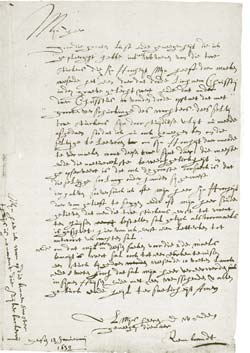 Rembrandt's third letter to Huygens,*)
Rembrandt's third letter to Huygens,*) (see translation right)
* To this letter see Bruyn, J.,Nevertheless, Huygens supported their career for several years acting as a sort of agent, brokering their works to international collectors. He assisted Lievens in his move to England to seek his fortune as a court portraitist, and secured Rembrandt a considerable number of commissions for the Prince's gallery in The Hague including a five part series of the Passion of Christ: The Raising of the Cross (c. 1633), The Decent from the Cross (c. 1633), The Entombment, (1639), The Resurrection, (1639) and The Ascension of Christ, (1636).
All the five paintings are housed in the Alte Pinakothek Munich. See also Rembrandt. Life, paintings, etchings, drawings & self portraits.
The paintings (oil on canvas) all shared the format of 92 x 70 cm. with an arched top in the style of an altarpiece. Rembrandt began this imposing project in 1633 but his progress was overshadowed by problems with delays in the delivery and subsequently, with the payment. The last two paintings were finished six years later in 1639. Seven letters by Rembrandt to Huygens have survived (but not one from Huygens to Rembrandt) which describe these circumstances. These are the only letters we have from Rembrandt. Huygens found the two artists difficult to work with due to what he described as, their being "carelessly content with themselves."
As the Orange-court gradually was seduced by the Flemish art of painting, particularly by Antwerp masters, in 1639 Huygens requested Peter Paul Rubens to paint a picture for the court, according to his own ideas, but with no more than three or four figures. Letters were exchanged discussing the details of the project but unfortunately the work was never executed due to Rubens' death in 1640. Since Anthony van Dijck, Rubens' most talented disciple, died shortly thereafter in 1641, the court turned to Thomas Willeboirts (1614–1654) and Gonzales Coques (1614–1684), both from Antwerp. Huygens had to manage the correspondence, the negotiations with the artists and the execution of the commissions, and with practical matters such as arranging the delivery and payment.
But Huygens' official profession as an advisor for the arts was highly prized by various national and international art connoisseurs. For Huygens' hypothetical role as an intermediary for the work of Johannes Vermeer see Music in the Time of Vermeer, chapter 2.
If you discover a  or anything else that isn't working as it should be, I'd love to hear it! Please write me at: jonathanjanson@essentialvermeer.com
or anything else that isn't working as it should be, I'd love to hear it! Please write me at: jonathanjanson@essentialvermeer.com